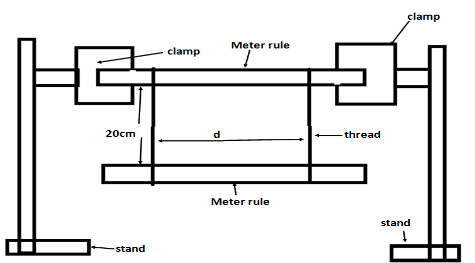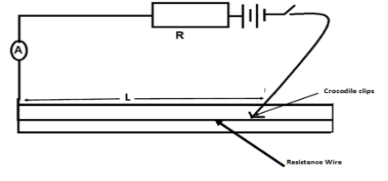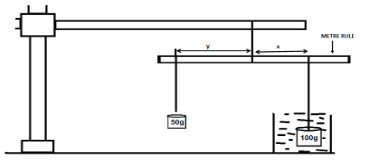- Answer ALL the questions in the spaces provided in the question paper.
- You are supposed to spend the first 15 minutes of the 2½ hours allowed for this paper reading the whole paper carefully before commencing your work.
- Marks are given for a clear record of the observations actually made, their suitability, accuracy and the use made of them.
- Candidates are advised to record their observations as soon as they are made.
- Non-programmable silent electronic calculators may be used.
- Candidates should answer the questions in English.
QUESTION 1
You are provided with
- 2 metre rulers
- A half metre rule
- Two complete stands
- 2 pieces of thread, each 40 cm long
- Stop watch
- Vernier calipers (can be shared)
-
- Using the Vernier caliper measure the width of the metre rule = ____________cm. (1 Mk).
Thickness of the metre rule = ___________________cm (1 Mk) - Find the volume of the material of the metre rule:
Volume =________________cm3 (1mk) - Find the density of the material of the meter rule given that it has a mass of 100g
Density = ______________________g/cm3 (1mk)
- Using the Vernier caliper measure the width of the metre rule = ____________cm. (1 Mk).
- Now set up the apparatus as shown in the diagram below
Ensure the loops of the thread are loose for easy sliding of the threads along the rulers. The separation between the two meter rules must remain 20cm throughout the experiment. - Adjust the position of the threads such that one is on the 10cm mark and the other on the 90cm. mark so that d = 80cm.
Maintain the threads vertical by making the separation of the loops on the two rulers the same.
Displace one end of the lower meter ruler slightly on the horizontal plane so that when released it oscillates about a vertical axis as shown in the figure below.
Measure the time for 20 oscillations and record the values in the table given below. - Repeat the procedure in (c) for other values of d in the table (set the values of d by adjusting the position of the loops in steps of 5cm on both sides of the meter rules.
Complete the table below (6mks)
d (cm) d (cm) 1/d2(m−2) Time for 20 oscillations t(s) Period T (s) T2 (S2) 80 60 50 40 30 20 - Plot a graph of T2 (S2) against 1/d2 (m−2) (5MKS)
- determine the slope of the graph (3mks)
- given the equation of the graph is T2 = 16K2
d2
Use the graph to find the value of K (2mks)
QUESTION 2
PART A
You are provided with the following apparatus.
- 2 new dry cells size D (1.5 V)
- A cell holder
- One 100cm resistance wire mounted on a millimeter scale
- One switch
- One voltmeter 0-3v
- One ammeter 0-1A
- 8 connecting wires (4 with at least 1 crocodile clip)
- Resistor wire mounted on card board
- Connect the circuit as shown below
- Adjust the position of crocodile clip on the resistance wire to a point such that L = 10CM.
- Record in the table below the value of P.D across R and corresponding current through R.
- Repeat procedure in (b) and (c) Above, for L =20, 30, 40, 50, 60, 70 and 80cm.
TABLE OF RESULTS
| L(CM) | 10 | 20 | 30 | 40 | 50 | 60 | 70 | 80 |
| V(VOLTS) | ||||||||
| I(AMPERES) |
- On the grid provided plot the graph of V(Y - Axis) against I(X - Axis) (5Mks)
- Find the slope of the graph (3mks)
- What quantity is represented by the slope of the graph? (1mk)
PART B
You are provided with the following
- Metre rule
- Retort stand , clamp and boss
- 500ml beaker ¾ full of water
- 100g mass
- 50gm mass
- 3 pieces of thread
Proceed as follows
- Balance the meter rule horizontally by suspending it from the stand and clamp with one of the threads. Record the balance point G. (1MK)
-
- Suspend the 100g mass from the meter rule at a point X such that X =10cm from point G. with 100g mass completely immersed in water in the beaker, hang the 50g mass from the meter rule and adjust its position until the system is in equilibrium as shown in the diagram below.
Note the point of suspension P of the mass 50g (1mk) - Measure distance Y. (1mk)
- Using the information above, calculate the up thrust on the 100g mass if the density of Water is 1000kg/m3 (4mks)
- Suspend the 100g mass from the meter rule at a point X such that X =10cm from point G. with 100g mass completely immersed in water in the beaker, hang the 50g mass from the meter rule and adjust its position until the system is in equilibrium as shown in the diagram below.
CONFIDENTIAL
QUESTION 1
Each candidate must be provided with the following
- metre rulers
- A half metre rule
- Two complete stands
- 2 pieces of thread, each 40 cm long
- Stop watch
- Vernier calipers (can be shared)
QUESTION 2(PART A)
Each candidate must be provided with the following
- Two new dry cells size D (1.5 V)
- A cell holder
- One 100cm resistance wire mounted on a millimeter scale (SWG 32)
- One switch
- One voltmeter 0-3v
- One ammeter 0-1A
- 8 connecting wires (4 with at least 1 crocodile clip)
- Resistor wire of length 25cm mounted on card board or cartoon (SWG 28)
QUESTION 2 (PART B)
Each candidate must be provided with the following
- Metre rule
- Retort stand , clamp and boss
- 500ml beaker ¾ full of water
- 100g mass
- 50gm mass
- 3 pieces of thread
MARKING SCHEME
-
-
- Width = 3.02cm 1 mk
Thickness = 0.72cm 1 mk - Volume = 3.02 x 0.72 x100
=217.44cm3 1 mk - Density = mass
volume
= 100g
217.44
= 0.46g/cm3 1 mk
- Width = 3.02cm 1 mk
-
d (cm) d (cm) 1/d2(m−2) Time for 20 oscillations t(s) Period T (s) T2 (S2) 80 0.80 1.56 13.00 0.65 0.42 60 0.60 2.78 16.00 0.80 0.64 50 0.50 4.00 20.00 1.00 1.00 40 0.40 6.23 25.00 1.25 1.56 30 0.30 11.11 33.00 1.65 2.70 20 0.20 25.00 50.00 2.50 6.25 1 MK Each correct value ½ mk. Total 3 mks 1mk 1mk -
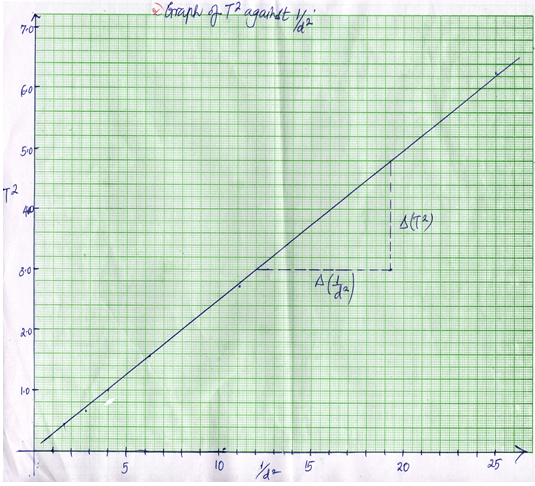
Labelling axes – 1mk
Scale – 1mk
Plotting – 2mks
Straight line – 1mk
Total - 5mks - Slope = 48 – 3.0 (3mks)
19.3 - 11.2
= 0.2222 - T2 = 16K2
d2
Y = mx +c
Gradient = 16K2
5
0.2222 = 16K2
5
K = 0.2635 2mks
-
2. PART A
d) TABLE OF RESULTS
| L(CM) | 10 | 20 | 30 | 40 | 50 | 60 | 70 |
| V(VOLTS) | 1.20 | 1.15 | 1.05 | 0.95 | 0.90 | 0.85 | 0.80 |
| I(AMPERES) | 0.23 | 0.22 | 0.20 | 0.18 | 0.17 | 0.16 | 0.15 |
-
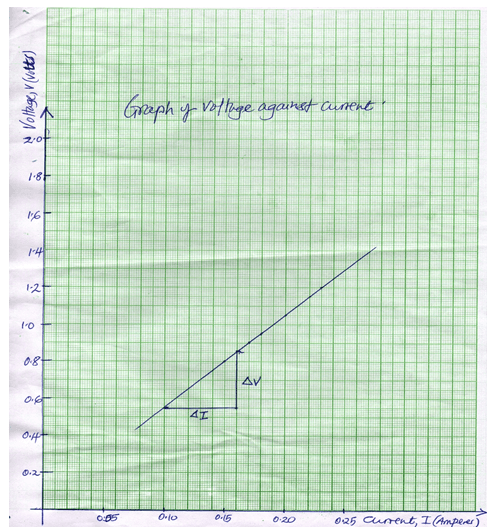
Labelling axes – 1mk
Scale – 1mk
Plotting – 2mks
Straight line – 1mk - Slope = ΔV = 0.85 − 0.55 = 0.30V = 5.0 Ω (3mks)
ΔA 0.16 − 0.10 0.06A - Slope represents resistance of the resistor R (mounted on cardboard) = 1mk
2 PART B
- G = 50 ± 0.5 CM………………………………………….1mk
-
- P = 67.3 ± 0.5 CM…………………………………..1mk
- y = 67.3 – 50 = 17.3 cm …………………………1mk
- Clockwise moment = anticlockwise moment
= 50 x 10 x Y = ( 100 × 10 – U) × X ……………………….….1mk
1000 1000
0.5 Y = (1 − U) X…………………………………………………………1mk
0.5 X 17.3 = (1 − U) X 10
8.65 = 10 – 10U
10U = 10-8.65
10U = 1.35
U = 1.35 ……………………………………………………………….…..1mk
10
= 0.135 N…………………………………………………………………1mk
Download Physics Paper 3 Questions and Answers with Confidential - Form 4 End Term 2 Exams 2023.
Tap Here to Download for 50/-
Get on WhatsApp for 50/-
Why download?
- ✔ To read offline at any time.
- ✔ To Print at your convenience
- ✔ Share Easily with Friends / Students

